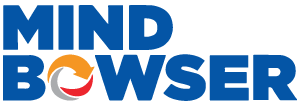11 Key Benefits:
It’s Monday morning at a mid-sized primary care clinic. The waiting room is full, phones are ringing nonstop, and the front desk is juggling patient check-ins, insurance verifications, and last-minute scheduling changes. A misplaced paper file delays a provider’s first appointment. Claims from last week still need review before submission. In the middle of it all, a patient walks out after waiting too long.
This is the daily reality for many practices operating without a unified patient management system. Without the right technology, administrative work can overwhelm staff, errors can slow down reimbursements, and patients may feel overlooked.
Patient management software (PMS) offers a solution by consolidating scheduling, billing, communication, and reporting into a single platform. It streamlines operations, reduces the administrative burden on staff, and enables providers to focus more easily on delivering care.
Beyond operational efficiency, PMS plays a crucial role in enhancing the patient experience. From enabling online appointment booking to providing secure communication portals, it helps practices stay connected with patients before, during, and after visits. The result is not just smoother workflows, but stronger relationships and better health outcomes.
In this article, we’ll examine the top 11 benefits of patient management software, compare it with electronic health record (EHR) systems, identify the most important integrations, and discuss where this technology is headed next.
Healthcare technology is often categorized into broad groups, but patient management software (PMS) and electronic health records (EHRs) serve distinct purposes. Understanding their differences and how they work together is essential when evaluating tools for your practice.
An electronic health record is a digital version of a patient’s medical chart. It focuses on the clinical side of care, housing information such as:
EHRs are primarily designed for providers to document and track a patient’s clinical journey over time. They support compliance with regulatory standards, facilitate information sharing among care teams, and ensure the accurate and secure storage of health data.
Patient management software centers on the operational and administrative functions of running a practice. Its role is to streamline nonclinical workflows such as:
While EHRs focus on medical content, PMS focuses on keeping the business side of a healthcare practice efficient and patient-friendly.
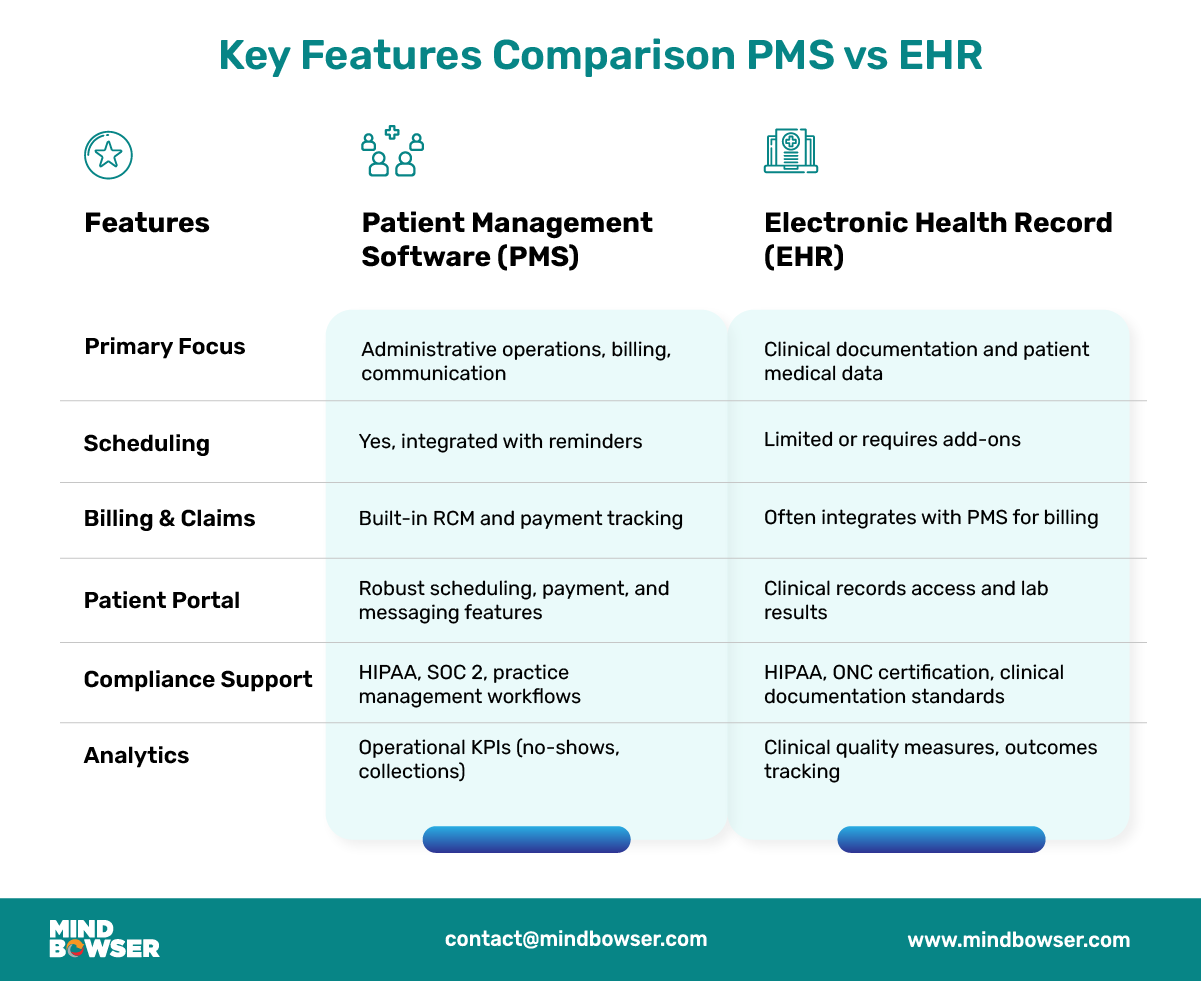
In a well-integrated environment, PMS and EHR platforms share data seamlessly. For example:
This coordination reduces duplicate data entry, minimizes errors, and enables both administrative and clinical teams to work from a single, accurate source of truth.
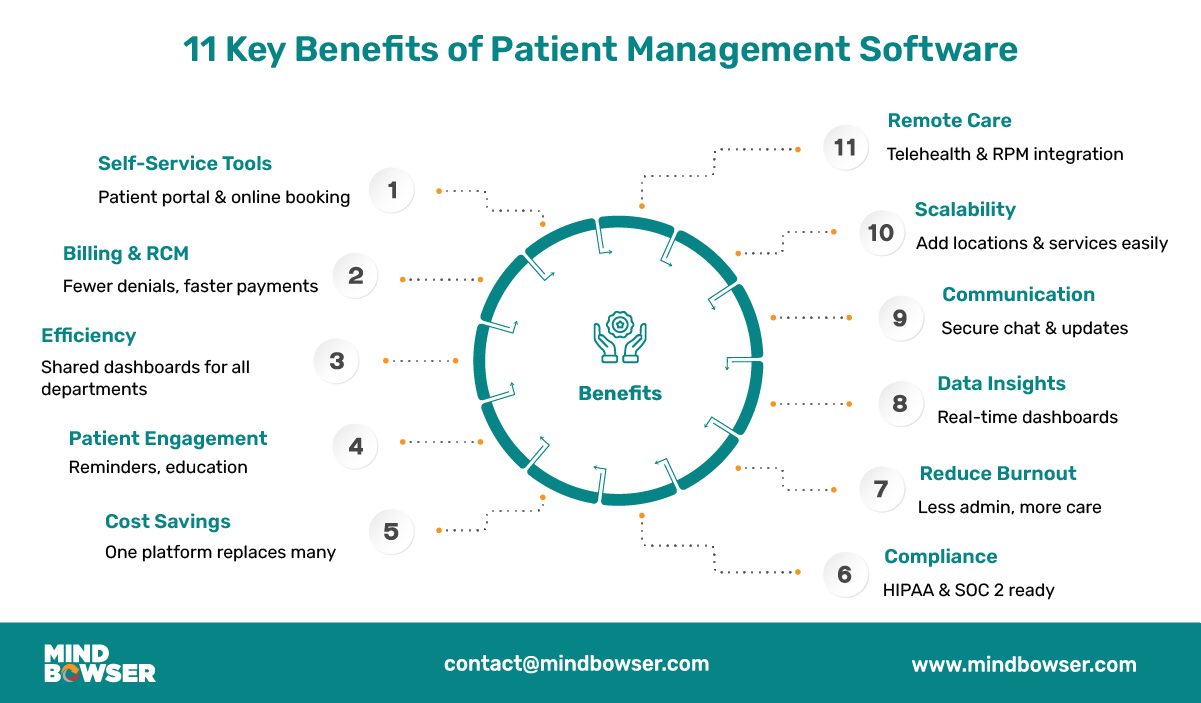
A remote care organization serving elderly patients faced a recurring problem: low patient engagement and missed readings due to confusing apps and inconsistent communication. Many of their users weren’t tech-savvy, and traditional RPM apps weren’t designed with accessibility in mind.
To address this, the team implemented a mobile-first remote patient monitoring (RPM) platform with features like:
The results were telling:
This success underscores how modern patient management software, when designed with usability in mind—can drastically improve both patient experience and operational flow.
Our AutoConfirm AI, a pre-built workflow, has delivered similar results for other practices by sending SMS and email reminders that integrate directly with the scheduling system, reducing missed appointments without requiring manual follow-up.
A value-based primary care network faced two persistent issues: claims were often delayed due to incorrect coding, and payment tracking was fragmented across tools. These inefficiencies created cash flow bottlenecks, frustrated staff, and resulted in missed follow-ups when insurance denials weren’t resolved in time.
To address this, they adopted a centralized patient management system integrated with billing automation and EHR data. Over the next quarter, they:
The system helped providers focus less on paperwork and more on care by flagging coding issues before submission and enabling faster denial resolution.
ClaimSolve by Mindbowser is a workflow that offers a similar solution stack:
These tools reduce manual effort, improve first-pass claim acceptance rates, and offer greater visibility into payment pipelines.
A surgical practice we worked with struggled to coordinate pre-operative testing between departments. Test guidelines varied by specialty, and communications about patient clearance often happened via email or phone. This resulted in miscommunications, delayed approvals, and last-minute surgery cancellations, leading to wasted OR time and frustrated providers.
To address this, we helped the team implement a centralized patient management interface tailored to each user role—hospital admin, surgeon, and front desk staff. Each role had access to:
This shift led to:
In our HealthTech with Purpose Podcast Series, Dr. Michal Tzuchman Katz, Co-founder and CEO of Kahun, explained how introducing decision-support tools reduced the time physicians spent navigating complex medical information, allowing them to focus more on patient care and less on searching for answers.
A family medicine practice observed that patients frequently missed follow-up visits after being diagnosed with chronic conditions. They used their PMS to send educational content, appointment reminders, and prescription refill alerts through the patient portal. Within a year, adherence to diabetes follow-up visits rose from 61% to 78%.
Our CarePlan AI workflow automates the creation and delivery of individualized care plans, enabling patients to stay on top of their health goals more easily.
A home health provider previously used separate tools for scheduling, billing, and patient communication, each with its own subscription fees and logins. After transitioning to an all-in-one PMS, they reduced annual software costs by 30% and decreased training time for new staff.
We helped a remote monitoring provider consolidate multiple tools into a single platform. This cut software licensing costs by 30% and improved team productivity.
Learn how patient management systems can cut costs and streamline audits.
Compliance risks often stem from weak access controls, unencrypted data, and missing audit trails. A pediatric practice preparing for review discovered its systems lacked encryption and consistent permissions, putting it at risk of penalties, patient trust issues, and costly remediation.
By moving to a PMS with HIPAA and SOC 2 safeguards, including role-based access, encryption, and audit logs, the practice built a defensible compliance posture. It passed its audit smoothly, reduced long-term exposure to fines or breaches, and gained leadership confidence that compliance is embedded, not an afterthought.
Physicians often spend hours after clinic catching up on forms, follow-ups, and administrative tasks. For one primary care group, this workload eroded morale, cut into personal time, and drove turnover risk, directly impacting both patient care and provider retention.
A modern PMS streamlined workflows, automating follow-ups, pre-filling EHR data, and reducing clicks for repetitive tasks. Clinicians finished work during clinic hours, left on time, and felt more engaged. This improved satisfaction, retention, and created space to focus on building stronger patient relationships instead of paperwork.
An outpatient rehab center used to rely on monthly reports that were often outdated by the time they reached administrators. Their PMS now provides real-time dashboards tracking appointment fill rates, patient retention, and outstanding balances. Leadership can act quickly to address issues before they escalate and become more severe.
We helped a senior care platform design a patient portal that combined appointment booking, reminders, and health monitoring in one place. The result was a 90% engagement rate among elderly users, dramatically reducing missed visits.
A cardiology group saw frequent patient drop-offs between visits, largely due to fragmented communication. Patients with post-procedure concerns often left voicemails, waited days for responses, or reached the wrong provider altogether.
The group adopted a practice management system with integrated secure messaging. Patients could now send questions through the portal, receive timely responses, and view communication history for clarity. Asynchronous chat also allowed providers to respond between consults without being interrupted by phone calls.
A multi-location behavioral health group expanded from one clinic to six in under two years. Rapid growth introduced complexity: different EHR workflows, provider availability, billing inconsistencies, and patient confusion.
Instead of cobbling together separate systems, they invested in a scalable practice management platform that allowed:
Their system scaled without sacrificing performance or requiring a full IT team.
During the COVID-19 surge, a geriatrics-focused group shifted nearly 60% of appointments to virtual care. This included routine check-ins, medication reviews, and chronic condition management. Their challenge was to maintain high care standards while minimizing in-person exposure risk.
Their practice management system handled:
This kept care continuous for elderly patients, many of whom were high-risk and homebound.
The real strength of patient management software lies not just in its built-in features, but in how well it integrates with other healthcare systems and tools. Seamless integrations reduce duplicate data entry, prevent costly errors, and keep both the clinical and administrative sides of the practice aligned.

Integrating a PMS with an EHR ensures that scheduling, billing, and patient communication are tied directly to the clinical record. This means:
For example, a multi-site medical group linked its PMS to Epic, enabling real-time updates between front-office scheduling and provider notes, which in turn reduced missed charges and administrative delays.
Related read: Custom EMR/EHR Software Development Services: A Complete Guide
With virtual care now a permanent part of healthcare delivery, PMS systems that integrate telehealth tools can:
One mid-sized practice integrated its PMS with Zoom for Healthcare, making telehealth appointments as easy to manage as in-office visits while maintaining HIPAA compliance.
Integration with wearable devices and remote patient monitoring (RPM) systems allows providers to track patient vitals between visits. Examples include:
Our HealthConnect CoPilot has been used to connect Bluetooth-enabled devices with PMS platforms, enabling continuous care without adding extra manual work.
While many PMS platforms include built-in revenue cycle management, integrating with specialized billing tools can further enhance performance. This can:
For instance, integrating a PMS with a coding compliance platform helped one specialty clinic cut claim rejection rates by nearly a quarter.
Practices offering diagnostic testing benefit from PMS-to-lab system integrations, which:
This reduces turnaround time and eliminates errors from manual result entry.
Discover how leading practices integrate scheduling, EHRs, and remote monitoring into a single system.
Choosing the right patient management system is only half the job. The real challenge lies in implementing it without disrupting day-to-day operations. A structured rollout plan helps avoid delays, ensures staff adoption, and maximizes ROI from day one.
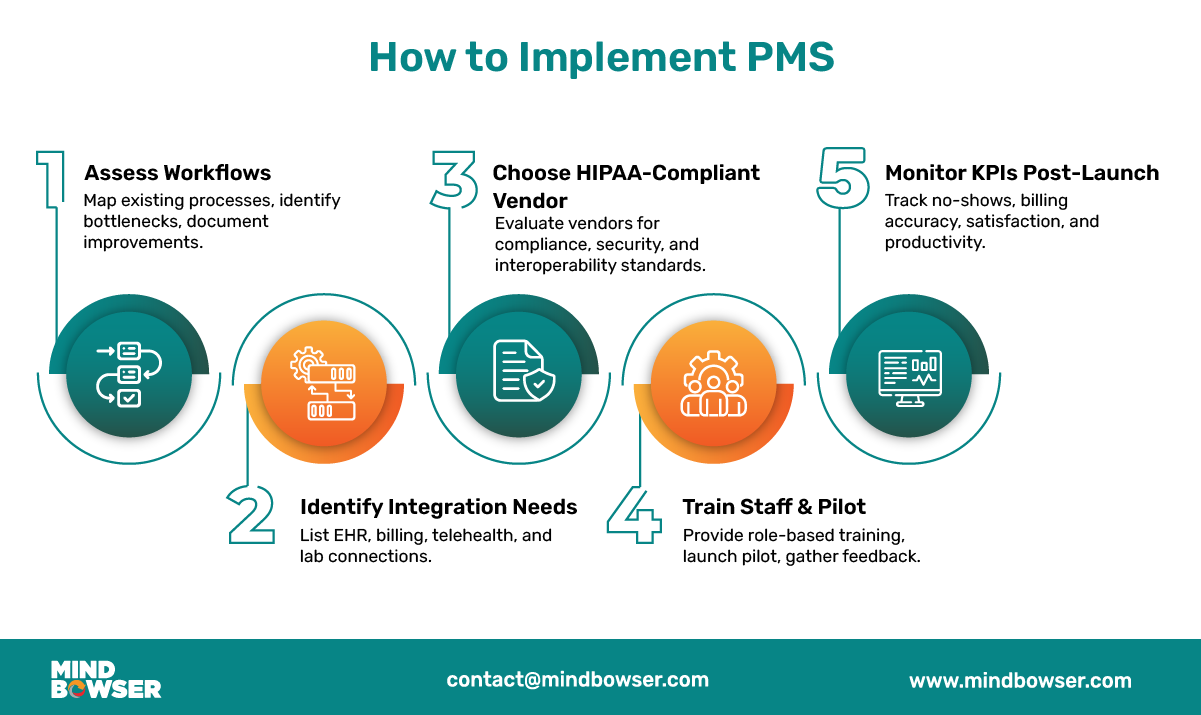
Before looking at software, map out how your practice currently manages:
Identify pain points and bottlenecks. This will help you choose a PMS that addresses your most urgent needs rather than chasing features you may not use.
A PMS rarely operates in isolation. Make a list of systems that will need to connect to it, such as:
Early integration planning prevents the costly mistake of buying a system that cannot “talk” to your existing tools.
Security and compliance must be non-negotiable. When evaluating vendors:
Mindbowser’s EHR Integration Services are designed to follow these standards, reducing the risk of compliance gaps after implementation.
Even the best software will fail if staff do not adopt it.
A phased rollout allows you to fine-tune settings and ensure the system is aligned with how your teams work.
Once live, track operational and clinical metrics such as:
Review these KPIs monthly in the first quarter after launch. The data will reveal whether the PMS is delivering on its promises and where further optimization is needed.
Selecting the right patient management software requires striking a balance between functionality, compliance, integration capability, and usability. The following platforms are among the most recognized in the market, each offering strong capabilities in scheduling, billing, and patient engagement.
Athenahealth’s patient management module integrates seamlessly with its cloud-based EHR. It offers intuitive scheduling, built-in revenue cycle management, and telehealth support. Analytics dashboards enable administrators to track operational performance in real-time.
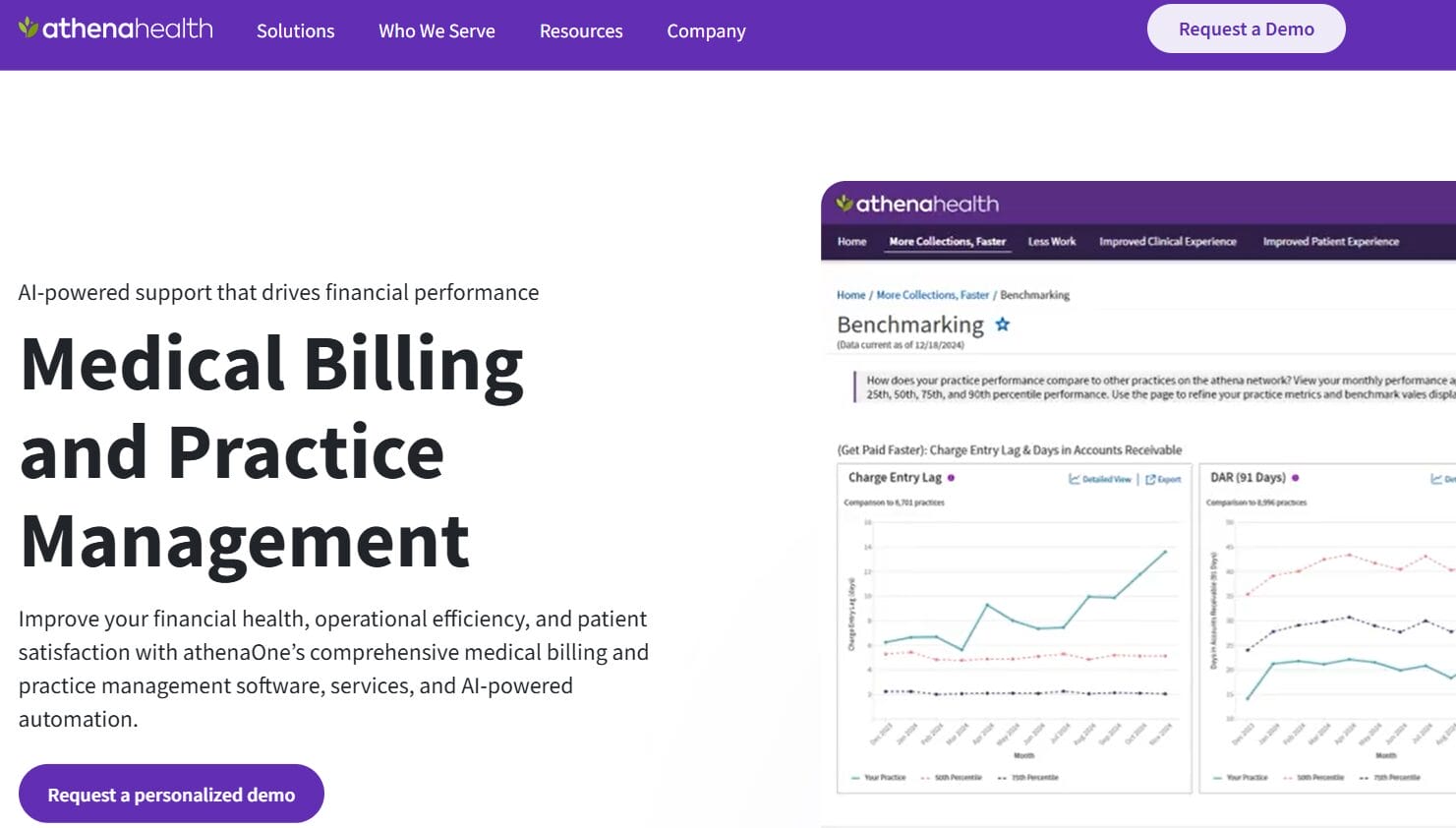
Designed with smaller and mid-sized practices in mind, Kareo offers straightforward appointment booking, billing, and patient communication features. Its cloud-based setup makes it accessible across multiple locations without heavy IT infrastructure.

AdvancedMD is a highly configurable platform with robust scheduling, claims management, and automation tools. Larger practices benefit from its workflow customization and ability to handle complex operational needs.
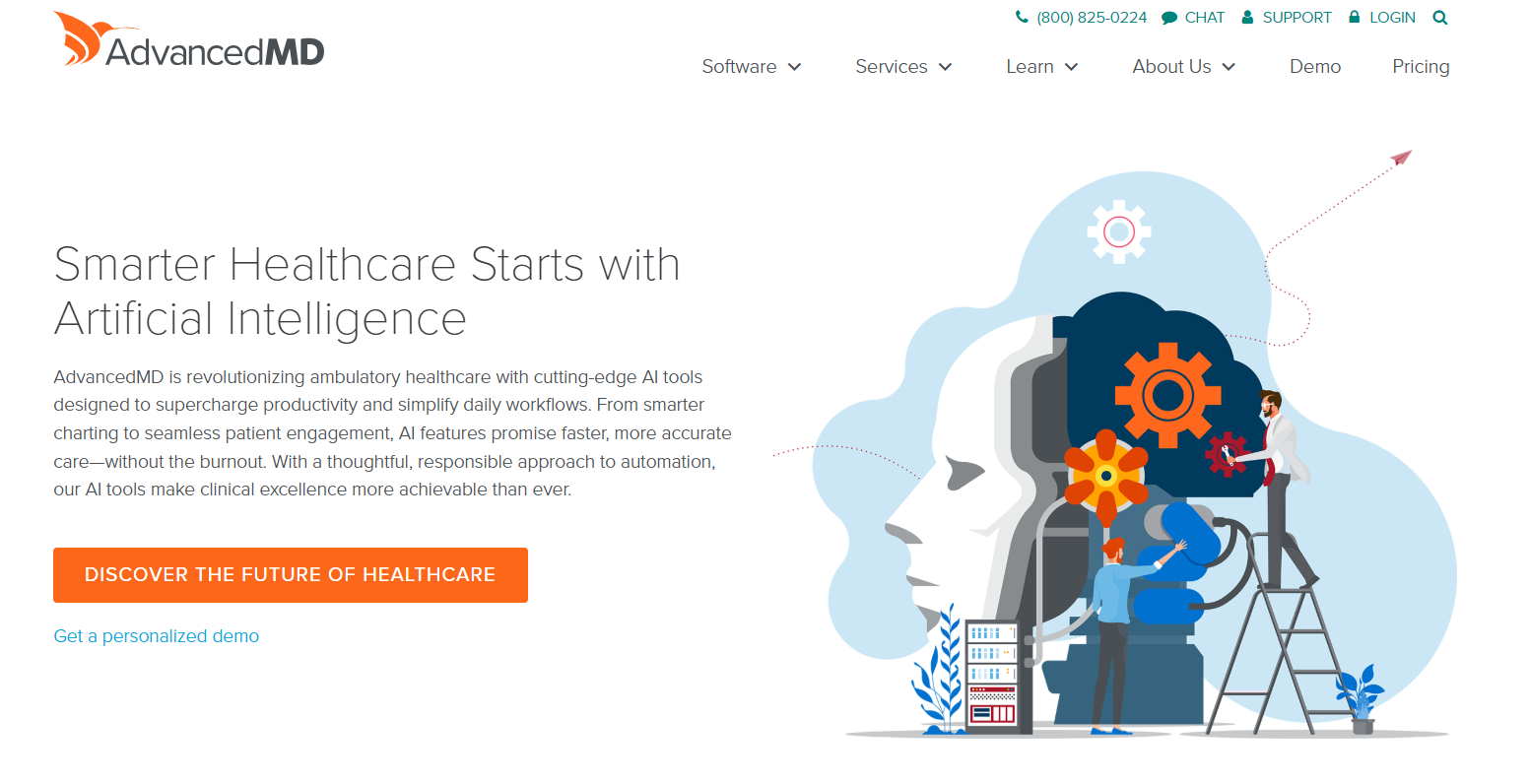
With a mobile-first design, DrChrono is ideal for providers who need access to schedules and patient data on the go. It includes integrated billing, customizable forms, and a patient portal, making it flexible for varied care settings.
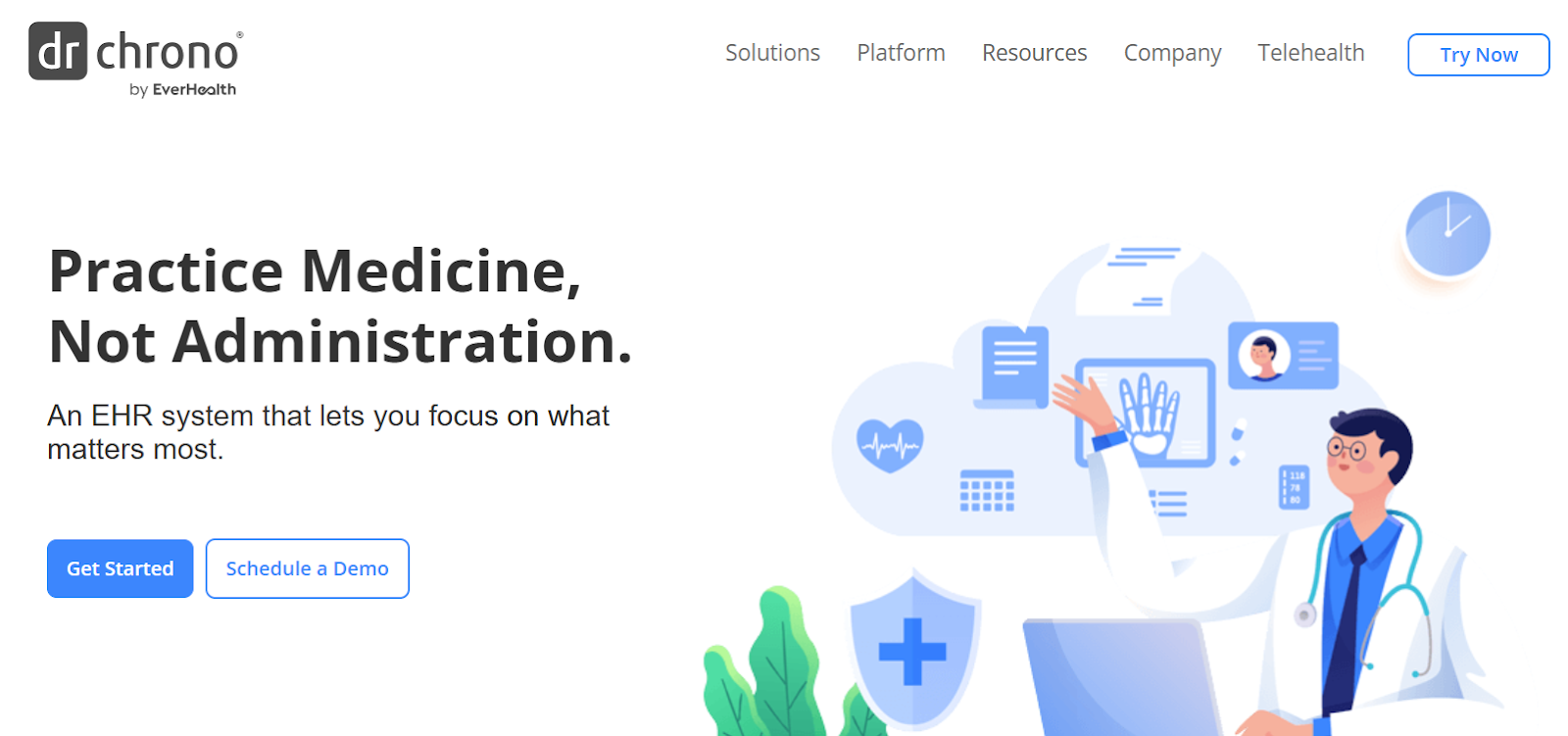
NextGen offers a feature-rich PMS suitable for multi-specialty practices. It emphasizes interoperability, advanced reporting, and patient engagement tools, making it a strong choice for organizations with diverse service lines.
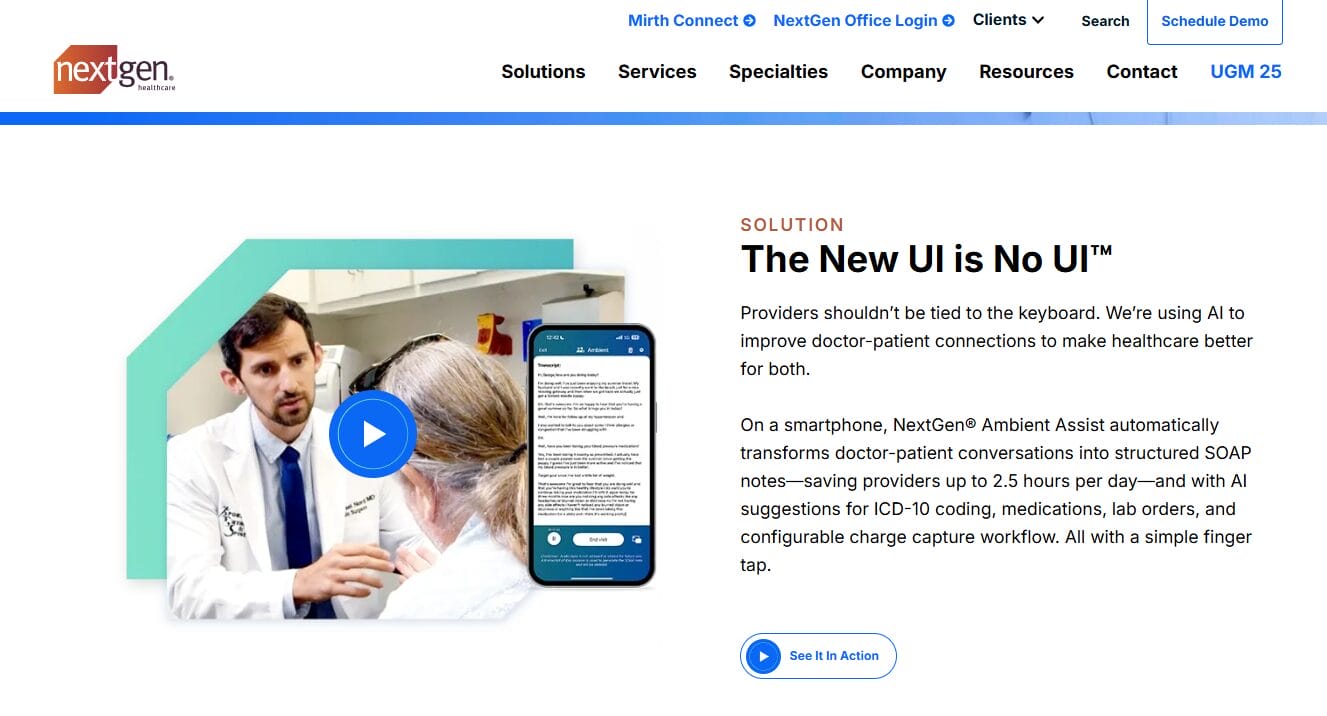
The next wave of patient management systems will go beyond basic scheduling and billing. Advancements in interoperability standards, artificial intelligence, and remote care technology are poised to make these platforms more proactive, intelligent, and integral to daily clinical operations.
Instead of simply filling open slots, future PMS platforms will analyze historical appointment data, patient demographics, and no-show patterns to optimize scheduling automatically.
Revenue cycle efficiency will benefit from AI-assisted coding suggestions that flag discrepancies in real-time.
The move toward Fast Healthcare Interoperability Resources (FHIR) is accelerating. Future PMS platforms will use FHIR APIs to:
With chronic disease management continuing to drive healthcare demand, PMS systems will increasingly integrate directly with RPM devices.
Rather than linking to external resources, PMS platforms will deliver patient-specific educational content within the portal.
Advances in speech recognition will allow clinicians and staff to interact with PMS systems hands-free.
The trajectory of patient management software points toward more integrated, intelligent, and patient-centered systems. Practices that invest in platforms with strong interoperability and adaptability today will be better positioned to leverage these innovations tomorrow.

Patient management software has evolved into an essential tool for modern healthcare practices. It not only streamlines operations but also supports better patient experiences, stronger care coordination, and improved financial performance. With the right system in place and the right integrations, practices can work more efficiently today while preparing for the technology demands of tomorrow.
From self-service scheduling to predictive analytics and remote monitoring, the right PMS can be the backbone of a more connected, patient-centered care model.
Ready to upgrade your practice operations? Explore how a modern patient management system can improve patient satisfaction, reduce costs, and prepare you for the future.
Patient management software handles the operational aspects of a practice, including scheduling, billing, communication, and reporting. EHR systems store and manage clinical records. Both can be integrated to create a comprehensive view of patient care.
By automating reminders, enabling secure communication, and providing easy access to educational resources, PMS helps patients stay engaged and adhere to care plans.
Most reputable systems are HIPAA-compliant, offering encryption, role-based access, and audit trails to protect patient health information.
Implementation time varies from a few weeks to several months, depending on practice size, system complexity, and integration requirements.
Yes. Many PMS platforms offer API-based integrations with leading EHRs, enabling seamless data sharing without duplicate entry.

We worked with Mindbowser on a design sprint, and their team did an awesome job. They really helped us shape the look and feel of our web app and gave us a clean, thoughtful design that our build team could...


The team at Mindbowser was highly professional, patient, and collaborative throughout our engagement. They struck the right balance between offering guidance and taking direction, which made the development process smooth. Although our project wasn’t related to healthcare, we clearly benefited...

Founder, Texas Ranch Security

Mindbowser played a crucial role in helping us bring everything together into a unified, cohesive product. Their commitment to industry-standard coding practices made an enormous difference, allowing developers to seamlessly transition in and out of the project without any confusion....

CEO, MarketsAI

I'm thrilled to be partnering with Mindbowser on our journey with TravelRite. The collaboration has been exceptional, and I’m truly grateful for the dedication and expertise the team has brought to the development process. Their commitment to our mission is...
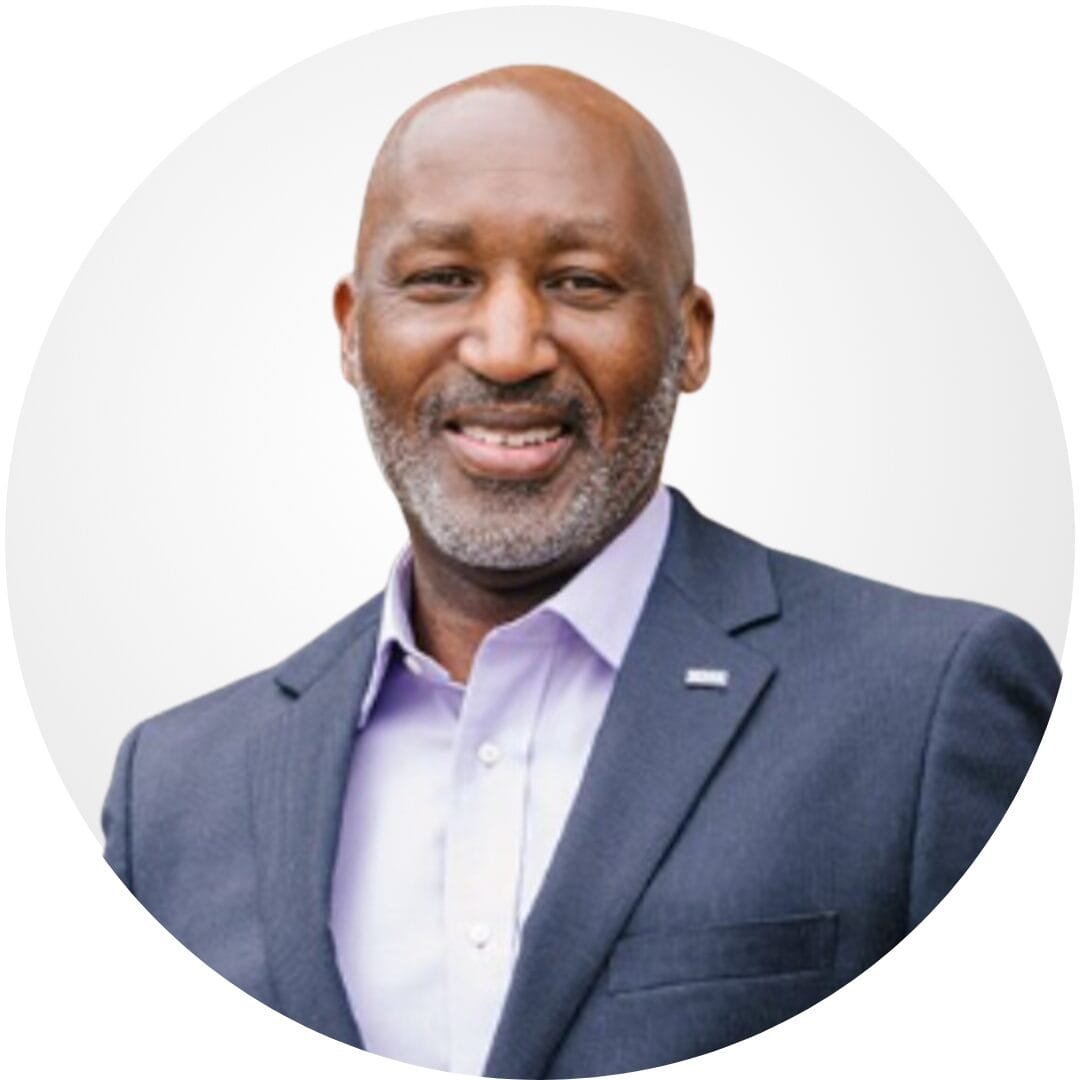
Founder & CEO, TravelRite

The Mindbowser team's professionalism consistently impressed me. Their commitment to quality shone through in every aspect of the project. They truly went the extra mile, ensuring they understood our needs perfectly and were always willing to invest the time to...

CTO, New Day Therapeutics

I collaborated with Mindbowser for several years on a complex SaaS platform project. They took over a partially completed project and successfully transformed it into a fully functional and robust platform. Throughout the entire process, the quality of their work...

President, E.B. Carlson

Mindbowser and team are professional, talented and very responsive. They got us through a challenging situation with our IOT product successfully. They will be our go to dev team going forward.

Founder, Cascada

Amazing team to work with. Very responsive and very skilled in both front and backend engineering. Looking forward to our next project together.

Co-Founder, Emerge

The team is great to work with. Very professional, on task, and efficient.

Founder, PeriopMD

I can not express enough how pleased we are with the whole team. From the first call and meeting, they took our vision and ran with it. Communication was easy and everyone was flexible to our schedule. I’m excited to...

Founder, Seeke

We had very close go live timeline and Mindbowser team got us live a month before.

CEO, BuyNow WorldWide

Mindbowser brought in a team of skilled developers who were easy to work with and deeply committed to the project. If you're looking for reliable, high-quality development support, I’d absolutely recommend them.

Founder, Teach Reach

Mindbowser built both iOS and Android apps for Mindworks, that have stood the test of time. 5 years later they still function quite beautifully. Their team always met their objectives and I'm very happy with the end result. Thank you!

Founder, Mindworks

Mindbowser has delivered a much better quality product than our previous tech vendors. Our product is stable and passed Well Architected Framework Review from AWS.

CEO, PurpleAnt

I am happy to share that we got USD 10k in cloud credits courtesy of our friends at Mindbowser. Thank you Pravin and Ayush, this means a lot to us.

CTO, Shortlist

Mindbowser is one of the reasons that our app is successful. These guys have been a great team.

Founder & CEO, MangoMirror

Kudos for all your hard work and diligence on the Telehealth platform project. You made it possible.

CEO, ThriveHealth

Mindbowser helped us build an awesome iOS app to bring balance to people’s lives.

CEO, SMILINGMIND

They were a very responsive team! Extremely easy to communicate and work with!

Founder & CEO, TotTech

We’ve had very little-to-no hiccups at all—it’s been a really pleasurable experience.

Co-Founder, TEAM8s

Mindbowser was very helpful with explaining the development process and started quickly on the project.

Executive Director of Product Development, Innovation Lab

The greatest benefit we got from Mindbowser is the expertise. Their team has developed apps in all different industries with all types of social proofs.

Co-Founder, Vesica

Mindbowser is professional, efficient and thorough.

Consultant, XPRIZE

Very committed, they create beautiful apps and are very benevolent. They have brilliant Ideas.

Founder, S.T.A.R.S of Wellness

Mindbowser was great; they listened to us a lot and helped us hone in on the actual idea of the app. They had put together fantastic wireframes for us.

Co-Founder, Flat Earth

Mindbowser was incredibly responsive and understood exactly what I needed. They matched me with the perfect team member who not only grasped my vision but executed it flawlessly. The entire experience felt collaborative, efficient, and truly aligned with my goals.

Founder, Child Life On Call

The team from Mindbowser stayed on task, asked the right questions, and completed the required tasks in a timely fashion! Strong work team!

CEO, SDOH2Health LLC

Mindbowser was easy to work with and hit the ground running, immediately feeling like part of our team.

CEO, Stealth Startup

Mindbowser was an excellent partner in developing my fitness app. They were patient, attentive, & understood my business needs. The end product exceeded my expectations. Thrilled to share it globally.

Owner, Phalanx

Mindbowser's expertise in tech, process & mobile development made them our choice for our app. The team was dedicated to the process & delivered high-quality features on time. They also gave valuable industry advice. Highly recommend them for app development...

Co-Founder, Fox&Fork
